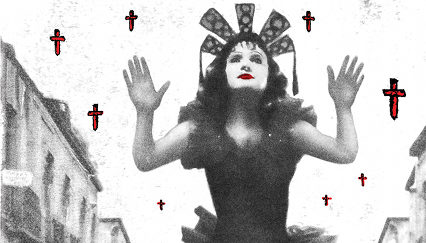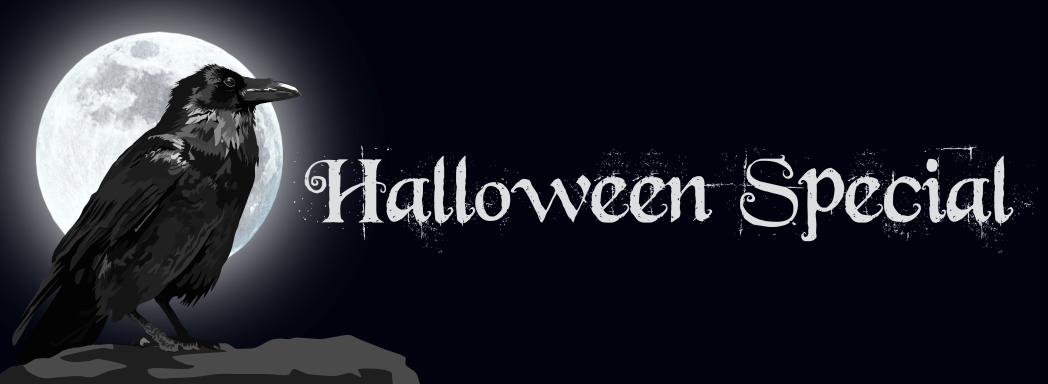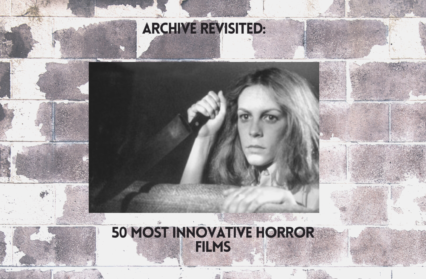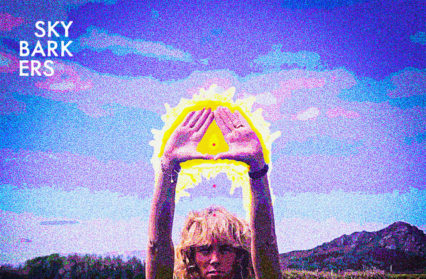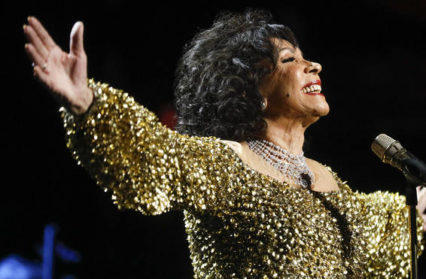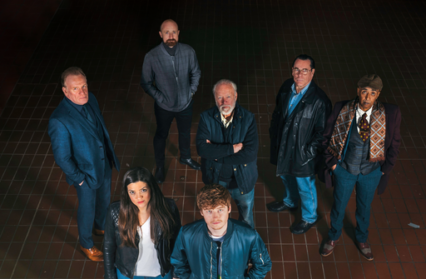Gary Raymond and Gray Taylor present a list of the greatest horror movies you may not have heard of – the perfect list for all those who are looking for something a little different on Halloween. Check out our final entry in this list with the 50 greatest horror movies 10-1!
(Banner illustration by Dean Lewis)
[Warning: Some of the accompanying trailers in this article are not for the fainthearted]
50 Greatest Horror Movies 10-1:
10. The Pit and the Pendulum (1960. Dir: Roger Corman)
Vincent Price was always value for money, never less than electrifying on screen, but in this second Edgar Allan Poe adaptation from Roger Corman, he is allowed the space to run amok in the deeply theatrical spaces of Corman’s colour-soaked sets. Price reels from manipulative to grief-stricken to sick to all-out maniacal insane in the space of an hour and forty minutes. It is barely Poe as far as the story is concerned, really just taking the cruelty of the idea behind the Inquisition torture device that makes the title. Corman had many triumphs back in these days, but this is the movie where he matched atmosphere with story, and cast with art design. Barbara Steele also deserves a mention for the way she slithers around the screen – she has never been better lit than she is in this film, even when moving through Bava’s shadows in Black Sunday. The Pit and the Pendulum has genuine frights – the very last shot is wonderful sign off – but the heavy shadow that hangs over it remains Poe’s: the fear and threat of the premature burial. The film is a claustrophobic nightmare in more ways than one. GR
9. From Beyond The Grave (1974. Dir. Kevin Connor)
Amicus Studios began making portmanteau horror collections with Dr Terror’s House Of Horrors (1965) and continued with varying success well into the 1970s. By the time this film was made, they had pretty much run their course but for this glorious final gasp for life. Peter Cushing plays an antiques shop owner who dishes out rather awful punishments to customers who decide to cheat him in someway. Every mini story is a classic here, be it David Warner compelled to brutally murder by a ghostly premonition in an antique mirror or a brilliantly sleazy Ian Bannen duped into participating in voodoo, every episode is brilliantly atmospheric. Classic seventies horror at its very best and entertaining. GT
8. Possession (1981. Dir: Andrzej Zulawski)
There is no film like Possession in the history of cinema, let alone on this list. A fierce, fast and swirling attack of the politics of East Germany, the early set up of some unravelling espionage thriller soon is consumed by a bizarre impressionistic painting cast in greys and cold blues, detached scrolls of monologues and violence, and, of course, some kind of unfurling slug alien that lives in the apartment upstairs. Sam Neil does a hearty job with what must have been a dizzying script and set, but it is Isabelle Adjiani who steals the show. Her famous scene of breakdown in the subway, where she appears to be collapsing from the inside, miscarrying whatever it is that is possessing her, is a searing, unforgettable moment that even in isolation carries with it a blistering shock. To really understand the film you might need to dedicate a PhD thesis to it, but to watch it, to experience it, evokes neither an analytic nor academic response. This film, if you have not seen it before, will blow you away. GR
7. Color Me Blood Red (1965. Dir. Herschell Gordon Lewis)
The third and final outing in his “blood trilogy”, low budget film maker HG Lewis here makes a slightly thoughtful and restrained horror film here. The grue is still bright red and we linger on the violence to an uncomfortable degree, but the story of a psychotic artist finding success by painting with his victim’s blood is a surprisingly accurate criticism of the pretensions of the art world. Yes it is basically a remake of Corman’s Bucket Of Blood (1960), but Lewis’ version in glorious color is a visual joy. Low budget doesn’t really cover it adequately but this is still a pure joy. GT
6. The Haunting (1960. Dir: Robert Wise)
The greatest haunted house movie ever made, and still, inexplicably, often missing from movie lists, Robert Wise created a film that very few directors or studios have had the guts to try and copy in the decades since. It is almost a cliche that the audience gets to see nothing in The Haunting – all of the scares are made through the power of suggestion – but it is the lack of the ability of the genre to recreate what Wise did that really marks his achievement. (Perhaps a fine display of this is in how the 1999 remake fills in all the gaps Wise left with CGI special effects to create one of the shittest films of all time). The premise is simple – a professor exploring supernatural goings on at the infamous Hill House invites a few carefully selected youngsters to stay a few nights with him. It is, of course, the house that is the villain, the house that will prey on the vulnerable, with all of its uneven angles and twisting staircases. If your idea of a great Halloween is a blanket pulled up to your nose having the bejeesus scared out of you by the things that go bump in the night, The Haunting is the movie for you. Just make sure you check whose hand you’re holding. GR
5. Carnival Of Souls (1962. Dir. Herk Harvey)
Another very low budget, American independent horror from the sixties, but this one’s claim to fame is that it pretty much single-handedly inspired a bona fide horror classic, Night Of The Living Dead (1968). When Mary Henry is involved in fatal car crash, rather than simply die she finds herself trapped in a netherworld followed and stalked by terrifying ghouls. The feeling of isolation, being watched, and the presence of a malevolent spirit world all combine to create a truly scary experience. This is a pure horror invention and the lack of money or professional actors cannot take away from it one bit. Creepy as it gets. GT
4. Daughters of Darkness (1971. Dir: Harry Kumel)
The fear of the vampire lies in the allure, the danger of wanting to be seduced despite the consequences. By the 1970s the more astute filmmakers were tapping into that with varied results, and although Harry Kumel’s Daughters of Darkness is without doubt a very sexy film, it would be unfair to lump it in with other horror erotica of that period. The original title explains a great deal in Kumel’s vision: Les Levre Rouge, (The Red Lips). This is a film about the only two things everyone on earth obsesses about – sex and death. Daughters of Darkness is exceptionally strange, exceptionally beautiful, and the sex comes from a fundamental understanding of the fears of desire and the ultimate vulnerability in those moments of physical relinquishment. In Delphine Seyrig we have the ultimate temptress, slitheringy sexy, oozing a kind of Weimar-Berlin cool; she treads a very thin line between sympathetic and appalling. It has style to spare, its punches are brutal, and at its heart there is a political message amid the tragic romanticism – that women are destined to be slaves to men in the current system of things. A movie that fully understands our fears, when you talk of the great vampire stories, this film must count among them. GR
3. Hausu (1977. Dir. Nobuhiko Obayashi)
This is one of the most visually inventive movies ever made. A schoolgirl travels with her classmates to her aunt’s home which seems to be possessed by some sort of demon and devours her friends one by one. No brief synopsis can adequately sum up the unbridled joy of Hausu. Director Obayashi was originally approached to make a film like Jaws; I would have loved to have seen their faces when they saw the finished product. Mixing filmic techniques into a surreal adventure, this is one of the most deftly made horror films of all time. Ingenious, creative, artistic, beautiful, a must for any horror fan. GT
2. Santa Sangre (1990. Dir: Alejandro Jodorowsky)
So much more than a horror film, but then Jodorowsky is so much more than a filmmaker. A dazzling, curious, mind-blowing cavalcade of images and sumptuous imaginative twists and turns. A magical take on the psycho-drama, sensitive and exploitative in equal measure. Young Fenix, aspirant circus child, witnesses the night his knife-thrower father cuts off the arms of his trapeze artist/religious nut mother, and he is never quite the same again. Jodorowsky’s son, Axel, plays the grown Fenix with an astounding sense of pathos and intensity, and the supporting cast move around the screen like a satanic inversion of a medieval mystery play. This is theatre, gothic and timeless, pulling in a multitude of horror traditions. There is no movie like Santa Sangre – it is a masterpiece of world cinema, not just of the horror genre. GR
1. Peeping Tom (1960. Dir: Michael Powell)
To the uninitiated Peeping Tom has always seemed a rather deranged right angle in Michael Powell’s glittering career as the one half of the Powell-Pressburger phenomenon. Archer Productions, their film company, is often remembered as creating rather dated, placid, quaint English movies about Englishness. But when Peeping Tom came out and shocked the world it was just another in a long line of innovative, gritty movies from one of the truly great directors of the era. The real shock of Peeping Tom is not that the serial killer is sadistic, or that he is insatiable, but rather that Powell puts the audience in his seat. As the excellently cold Carl Boehm murders the young girls he lusts after, he films them, trying to capture their terrified dying expression on a hand-held camera. Powell puts us in the lens, we see what the murderer sees. It is a cruel and powerful trick that ended Powell’s illustrious career – nobody would work with him or show his films after Peeping Tom. The man who brought us A Matter of Life and Death, The Life and Death of Colonel Blimp, The Red Shoes, Black Narcissus and countless other movies that will forever be listed in the greatest movies of all time was undone by his own artistic vision, and the power of the horror movie. A movie powerful enough to end that career must be worth experiencing. And it is our Number 1. GR
Click Here for 20-11


